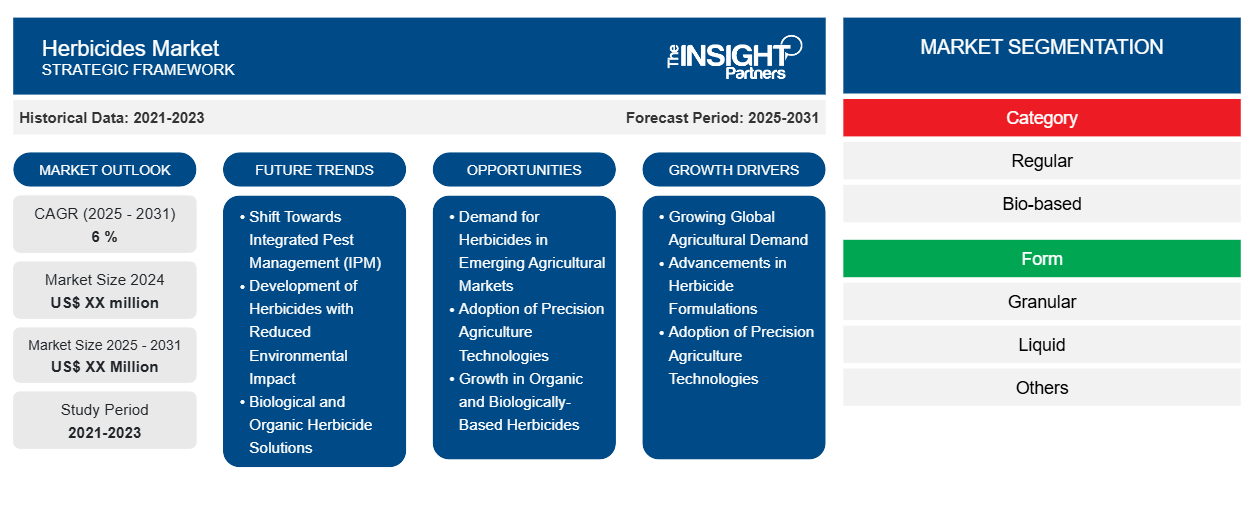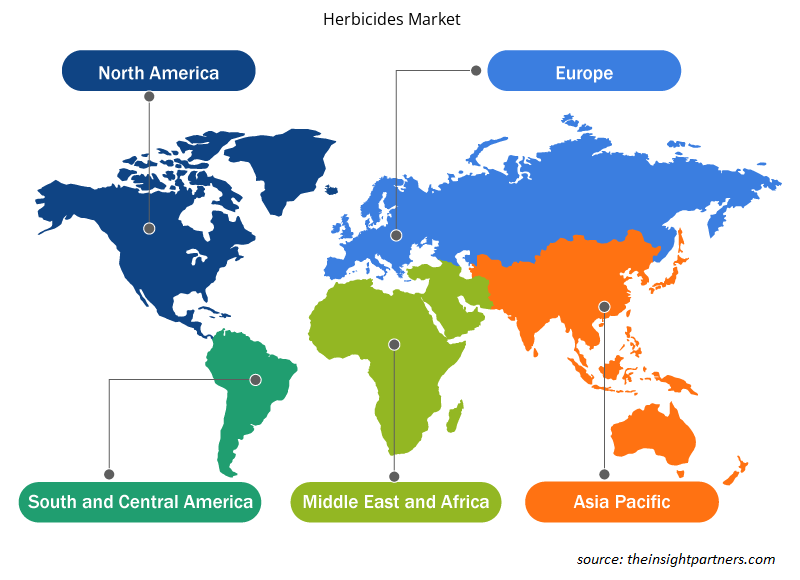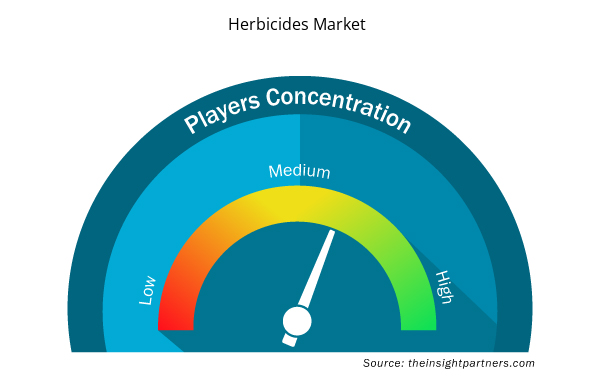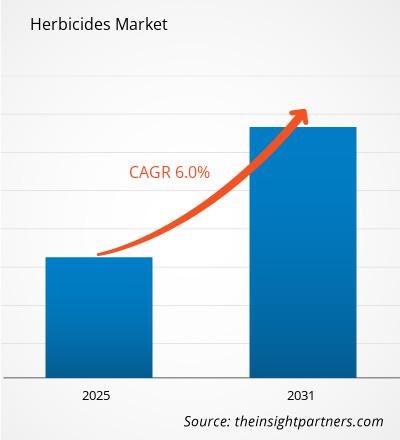The Herbicides Market is expected to register a CAGR of 6 % from 2025 to 2031, with a market size expanding from US$ XX million in 2024 to US$ XX Million by 2031.
The report is segmented by category (regular, bio-based), form (granular, liquid, others), and mode of application (seed treatment, soil treatment, foliar spray, others). The report further presents analysis based on application (fruits and vegetables grains and cereals, pulses and oilseeds, commercial crops, turf and ornamentals, others). Global analysis is further broken-down at regional level and major countries. In terms of geography, the market is divided into North America, Europe, Asia Pacific, Middle East and Africa, and South and Central America). The report offers the Value in USD for the above analysis and segments.
Purpose of the Report
The report Herbicides Market by The Insight Partners aims to describe the present landscape and future growth, top driving factors, challenges, and opportunities. This will provide insights to various business stakeholders, such as:
- Technology Providers/Manufacturers: To understand the evolving market dynamics and know the potential growth opportunities, enabling them to make informed strategic decisions.
- Investors: To conduct a comprehensive trend analysis regarding the market growth rate, market financial projections, and opportunities that exist across the value chain.
- Regulatory bodies: To regulate policies and police activities in the market with the aim of minimizing abuse, preserving investor trust and confidence, and upholding the integrity and stability of the market.
Herbicides Market Segmentation
Category
- Regular
- Bio-based
Form
- Granular
- Liquid
- Others
Customize This Report To Suit Your Requirement
You will get customization on any report - free of charge - including parts of this report, or country-level analysis, Excel Data pack, as well as avail great offers and discounts for start-ups & universities
Herbicides Market: Strategic Insights

- Get Top Key Market Trends of this report.This FREE sample will include data analysis, ranging from market trends to estimates and forecasts.
Herbicides Market Growth Drivers
- Growing Global Agricultural Demand: The need to increase agricultural output to meet the demands of a growing global population is a primary factor driving the herbicides market. As crop yields become more dependent on efficient weed management, herbicide usage is increasing across various crops such as grains, vegetables, and fruits. Herbicides help ensure optimal crop growth by controlling competition from weeds, ultimately boosting food production.
- Advancements in Herbicide Formulations: Continuous innovation in herbicide formulations is contributing to the growth of the herbicides market. Modern herbicides are more effective, less toxic, and often more selective in targeting specific weed species. New herbicide products that are resistant to environmental stressors, or that can be applied in reduced quantities, are helping farmers optimize their weed control practices while minimizing their environmental impact.
- Adoption of Precision Agriculture Technologies: The increasing use of precision agriculture tools—such as drones, GPS systems, and AI-driven analytics—is improving the efficiency and effectiveness of herbicide application. These technologies help optimize herbicide usage, reducing waste and environmental damage. As precision farming continues to expand, the demand for specialized herbicide solutions will likely grow.
Herbicides Market Future Trends
- Shift Towards Integrated Pest Management (IPM): The future of the herbicide market will likely be shaped by the increasing adoption of integrated pest management (IPM) practices. This holistic approach to pest control combines biological, mechanical, and chemical methods, reducing dependence on chemical herbicides. As farmers embrace more sustainable practices, there will be a rise in demand for herbicides that work synergistically with other pest management techniques.
- Development of Herbicides with Reduced Environmental Impact: With rising consumer and regulatory pressure for sustainable agriculture, herbicide manufacturers will focus on developing formulations with lower toxicity and environmental impact. The trend toward herbicides that break down more quickly in the environment or are highly targeted at specific weed species will continue, driven by consumer preference for "green" products.
- Biological and Organic Herbicide Solutions: The increasing demand for organic and natural farming solutions will drive innovation in biological herbicides. These herbicides, derived from plant extracts, essential oils, or microorganisms, offer eco-friendly alternatives to synthetic chemicals. As consumer demand for organic food and "chemical-free" farming increases, biological herbicides are expected to gain market share in the coming years.
Herbicides Market Opportunities
- Demand for Herbicides in Emerging Agricultural Markets: As agriculture intensifies in emerging markets to feed growing populations, the need for efficient weed control solutions will increase. Herbicides will play a key role in improving crop yields in regions such as Africa, Latin America, and Asia, where agricultural expansion is a priority. This offers significant growth opportunities for herbicide manufacturers to enter these new markets.
- Adoption of Precision Agriculture Technologies: The increasing adoption of precision agriculture, which uses technology to optimize farm operations, creates a significant opportunity for the herbicide market. Precision herbicide application, guided by drones, GPS, and sensors, can improve the effectiveness of herbicide use, reduce waste, and minimize environmental impact, driving demand for specialized herbicide formulations.
- Growth in Organic and Biologically-Based Herbicides: As consumer demand for organic and non-chemical food products grows, there is a rising opportunity for the development of biological and organic herbicides. Products derived from natural sources, such as essential oils and plant extracts, will become more popular in the herbicide market, catering to the organic farming sector and meeting regulatory demands for eco-friendly solutions.
Herbicides Market Regional Insights
The regional trends and factors influencing the Herbicides Market throughout the forecast period have been thoroughly explained by the analysts at Insight Partners. This section also discusses Herbicides Market segments and geography across North America, Europe, Asia Pacific, Middle East and Africa, and South and Central America.

- Get the Regional Specific Data for Herbicides Market
Herbicides Market Report Scope
| Report Attribute | Details |
|---|---|
| Market size in 2024 | US$ XX million |
| Market Size by 2031 | US$ XX Million |
| Global CAGR (2025 - 2031) | 6 % |
| Historical Data | 2021-2023 |
| Forecast period | 2025-2031 |
| Segments Covered |
By Category
|
| Regions and Countries Covered | North America
|
| Market leaders and key company profiles |
Herbicides Market Players Density: Understanding Its Impact on Business Dynamics
The Herbicides Market market is growing rapidly, driven by increasing end-user demand due to factors such as evolving consumer preferences, technological advancements, and greater awareness of the product's benefits. As demand rises, businesses are expanding their offerings, innovating to meet consumer needs, and capitalizing on emerging trends, which further fuels market growth.
Market players density refers to the distribution of firms or companies operating within a particular market or industry. It indicates how many competitors (market players) are present in a given market space relative to its size or total market value.
Major Companies operating in the Herbicides Market are:
- Adama Agricultural Solutions Ltd
- BASF SE
- Drexel Chemical
- FMC Corporation
- Monsanto Company
Disclaimer: The companies listed above are not ranked in any particular order.

- Get the Herbicides Market top key players overview
Key Selling Points
- Comprehensive Coverage: The report comprehensively covers the analysis of products, services, types, and end users of the Herbicides Market, providing a holistic landscape.
- Expert Analysis: The report is compiled based on the in-depth understanding of industry experts and analysts.
- Up-to-date Information: The report assures business relevance due to its coverage of recent information and data trends.
- Customization Options: This report can be customized to cater to specific client requirements and suit the business strategies aptly.
The research report on the Herbicides Market can, therefore, help spearhead the trail of decoding and understanding the industry scenario and growth prospects. Although there can be a few valid concerns, the overall benefits of this report tend to outweigh the disadvantages.
- Historical Analysis (2 Years), Base Year, Forecast (7 Years) with CAGR
- PEST and SWOT Analysis
- Market Size Value / Volume - Global, Regional, Country
- Industry and Competitive Landscape
- Excel Dataset



Report Coverage
Revenue forecast, Company Analysis, Industry landscape, Growth factors, and Trends

Segment Covered
This text is related
to segments covered.

Regional Scope
North America, Europe, Asia Pacific, Middle East & Africa, South & Central America

Country Scope
This text is related
to country scope.
Frequently Asked Questions
The report can be delivered in PDF/Word format, we can also share excel data sheet based on request.
BASF SE, Corteva, Syngenta, Bayer CropScience Limited, ADAMA, FMC Corporation, Nufarm, UPL, Sumitomo Chemical Co., Ltd., Nissan Chemical Corporation are the key players operating in the herbicides market.
Based on geography, North America held the largest share of the herbicides market.
There is a growing trend towards sustainable agricultural practices, leading to increased demand for environmentally friendly herbicides is one of the key trend in the herbicides market.
Growing global agricultural demand is driving the herbicides market growth
The Herbicides Market is estimated to witness a CAGR of 6 % from 2023 to 2031
Trends and growth analysis reports related to Chemicals and Materials : READ MORE..
1. Adama Agricultural Solutions Ltd
2. BASF SE
3. Drexel Chemical
4. FMC Corporation
5. Monsanto Company
6. Nissan Chemical Corporation
7. Nufarm Limited
8. Platform Specialty Products Corporation
9. Syngenta AG
10. The Dow Chemical Company

 Get Free Sample For
Get Free Sample For